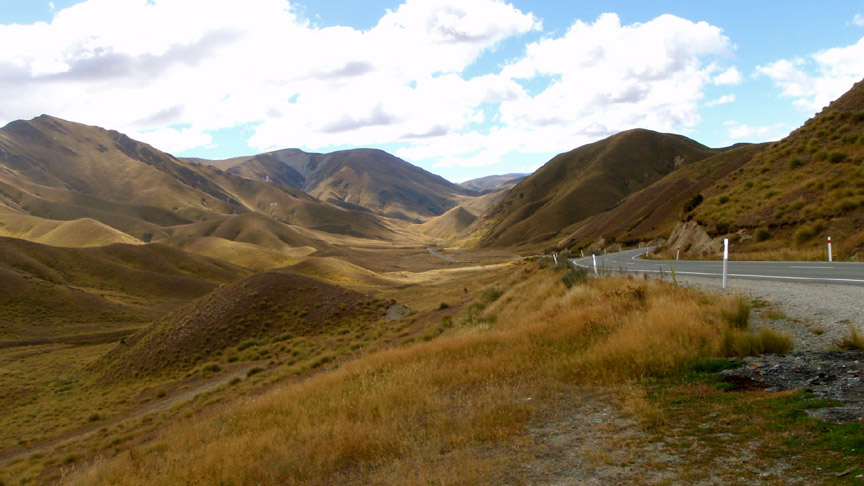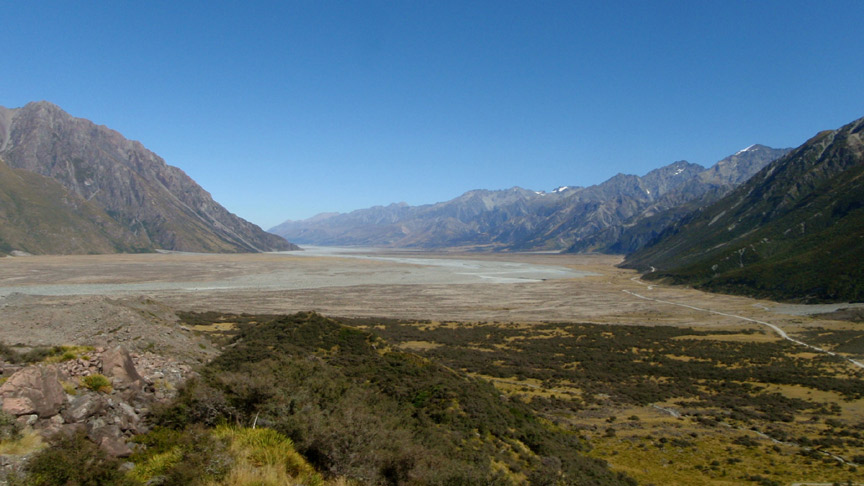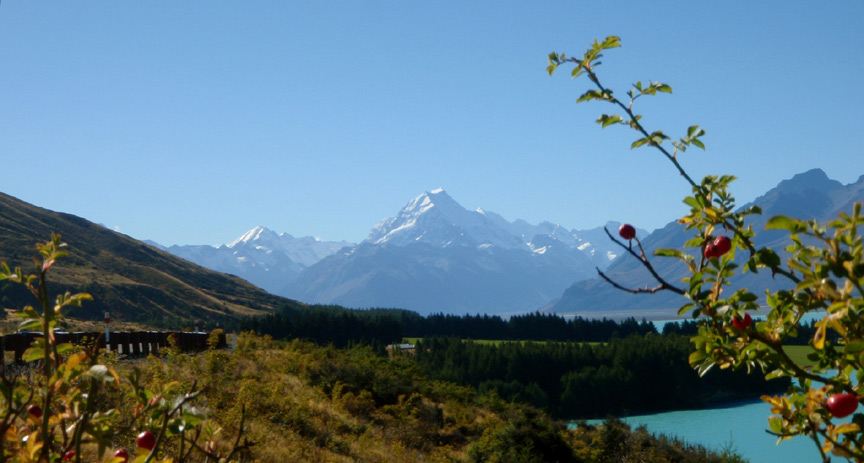A Sheep Farm B&B with a View - Twizel, South Island, New Zealand

Harmonie
Don and Anne Myers
Mon 27 Apr 2009 03:38
|
44:14.894S 170:06.857E
On March 21st, we left the Hobbit and the mostly
green rolling hills filled with sheep behind in the far south, and headed
back north through the arid foothills on the eastern side of the Southern Alps
to the small town of Twizel (pronounced Twyzel). Along the
way, the wet chill of the Catlins was replaced by a new sunshine bubble, which
lucky for us, happened to carry us through the rest of our South
Island land tour. Just outside of Twizel was our destination, Omahau
Downs, a B&B set on a working sheep farm. We never did see any
sheep (the owners said they were still in the higher altitude paddocks and
hadn't been brought down for the winter yet), but we did have a marvelous view
of Mt. Cook. The B&B consisted of a tiny, newly built, mobile-home
looking building with four rooms and a common kitchen and living room
area. Below are pictures from the Catlins to Twizel drive:
Picture 1 - Mostly green rolling hills filled with
sheep in the far south.
Picture 2 - Arid foothills on the eastern side of
the Southern Alps. Mom said these hills looked to her like gold
velvet. It's true. Although they were mostly barren, the
hills shimmered in the sun and looked like they might feel soft if you
happened to slide down one of their steep slopes on your butt.
We decided not to test the
velvety-soft-on-your-butt-while-sliding-down-steep-slopes theory
though.
Picture 3 - Our view of Mt. Cook from the
B&B. You might recall that we already saw Mt. Cook from the
helicopter, but that was the western side. A week
and approximately 750 miles later, we wanted a look at the
eastern side as well.
We stayed only two nights at the sheep farm
B&B, so only had one day to drive to Mt. Cook National Park and see the
Australasia mountain king. We didn't climb it, but we did get a good
look at its eastern side as well as its mountain
neighbors.
Picture 4 - The 45 minute drive from Twizel to
Mt. Cook National Park was straight down a wide
glacier-formed valley with Mt. Cook staring us directly in the face almost
the entire way. Only one road and the mountain looking right at us
made it very difficult to get lost. This was one particularly lovely view
of the mountain that morning.
Picture 5 - As we got closer, we got a
better look at Mt. Cook's glacier-wrapped
mountain neighbors. The car traffic on the right gives
a bit of perspective as to the enormity of these
monsters.
We arrived at the park's visitor's center and
stayed for a while. It was incredibly impressive as it had just been
renovated with all new displays, etc. Dad and I discovered the 'Memorial
Books', which documented all Mt. Cook area climbing accidents
that ended in death(s). Hundreds of deaths over the years.
Purely morbid, but we found it difficult to tear ourselves away. I was
surprised at the percentage of accidents (much greater than 50%) that
occurred on the way down, after the climbers had reached their summit
goal. I guess it makes sense when you think about a
climber's state of mind and body on the return trip - more relaxed,
but exhausted, less focused and on the downside of an adrenaline
high. All things we feel on the boat after a long passage, but usually
we've reached our summit by then which is generally a cozy anchorage, and lucky
for us, we don't have to turn around and do it all over again backwards
like the climbers do.
After the visitor's center, we moved on to the
walks. No waterfalls here so we opted for a glacier instead. Below
are pictures:
Picture 6 - Terminal end of Tasman Glacier.
Who says glaciers always have to be pretty? This is the melted end of
the giant Tasman Glacier. All that dirty snow and ice
look like the Buffalo roadsides in March. Well, maybe the
Buffalo roadsides in March on steroids. Lots of rock and gravel trash left
behind by the glacier. And the steel-gray color of the melted-glacier lake
is none too appealing either. The floating icebergs are kind of fun
though.
Picture 7 - Mom and Dad on top of the glacier's
rock and gravel dump. Don't they look cute?
Picture 8 - If you turn 180 degrees from the
glacier's ugly end, this is what you will see. An impossibly wide and flat
valley cut by the receding glacier, with the melted glacier stream
winding through it.
Picture 9 - This was our view as we left Mt. Cook
behind and drove out of the valley toward Twizel.
The second night at the sheep farm B&B, we
stayed in and grilled Dad-approved pork chops (no sauce!) on the shared barbeque
and sat down to dinner with the two other couples staying at the B&B.
All four of them were traveling together, and all were from Christchurch, a 3
hour drive away. Rex and Raewyn own a motorboat that they had brought
on a trailer out to Twizel for the weekend and some boating fun.
While we were bundled up in clothes appropriate for fall, Rex, Raewyn, Sean and
Claire were decked out in shorts and swimming togs for a day on the
water. These Kiwis are nothing if not hearty. Anyway, as we were all
leaving the B&B the next morning, Raewyn invited us to dinner for a 'Kiwi
Roast' the following evening at their home in Christchurch. Kiwi
hospitality is unbelievable. We meet these people at a B&B, share a
table with them for breakfast and dinner and suddenly we are invited to their
house for dinner. The plan worked out perfectly since we were headed to
Christchurch for the next two nights anyway, so we gladly accepted the
invitation. Oh, and in case you were wondering, a 'Kiwi Roast' does not
involve killing, roasting and eating the endangered and protected New Zealand
national bird. It doesn't involve roasting up a mess of kiwi fruit
either, it's just the name used to describe the typical New Zealander roast
meal - pork, vegetables and potatoes. Once Dad heard this, he looked
forward to the Kiwi Roast meal like there was no tomorrow.
Anne
.
|








